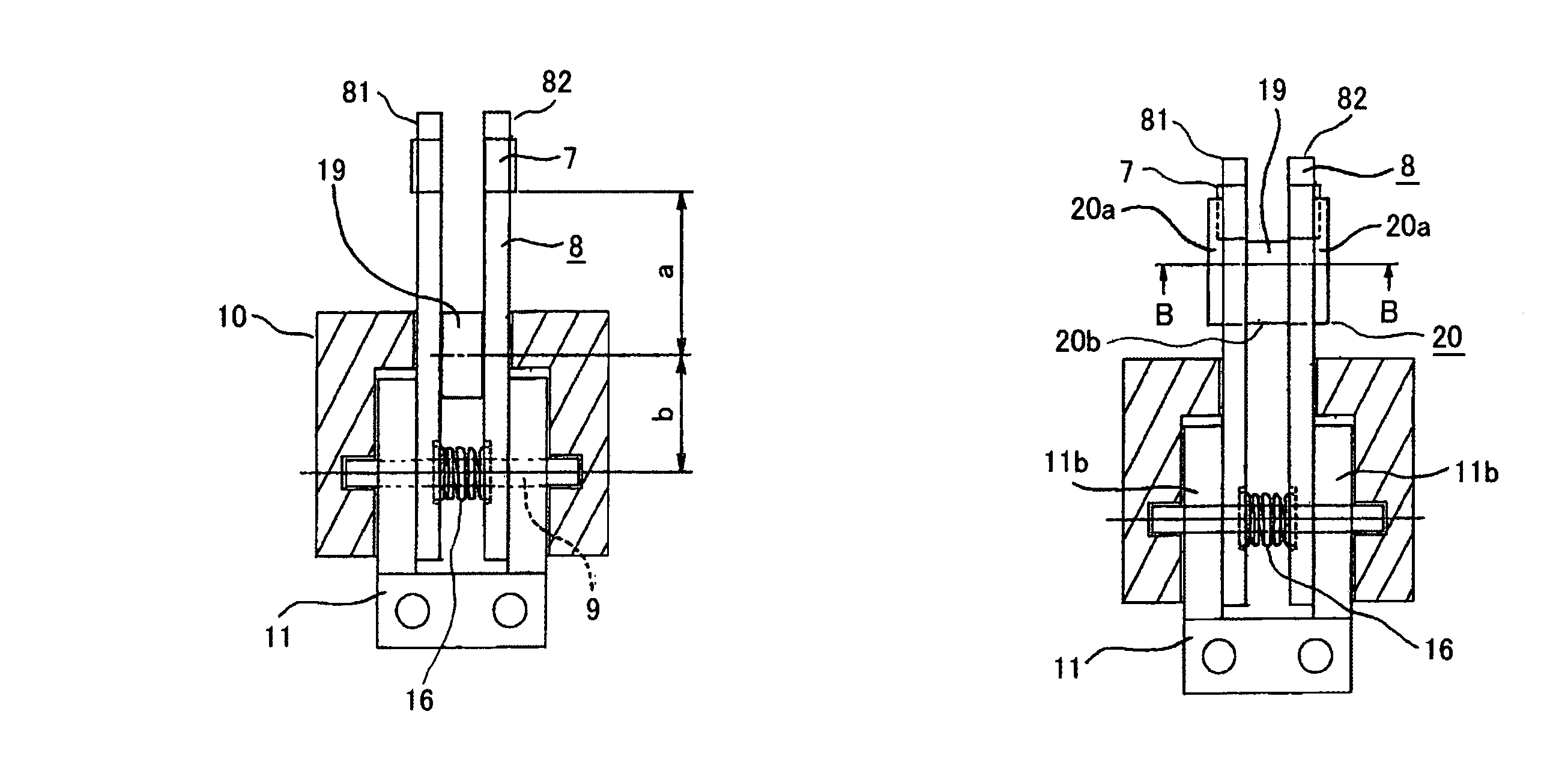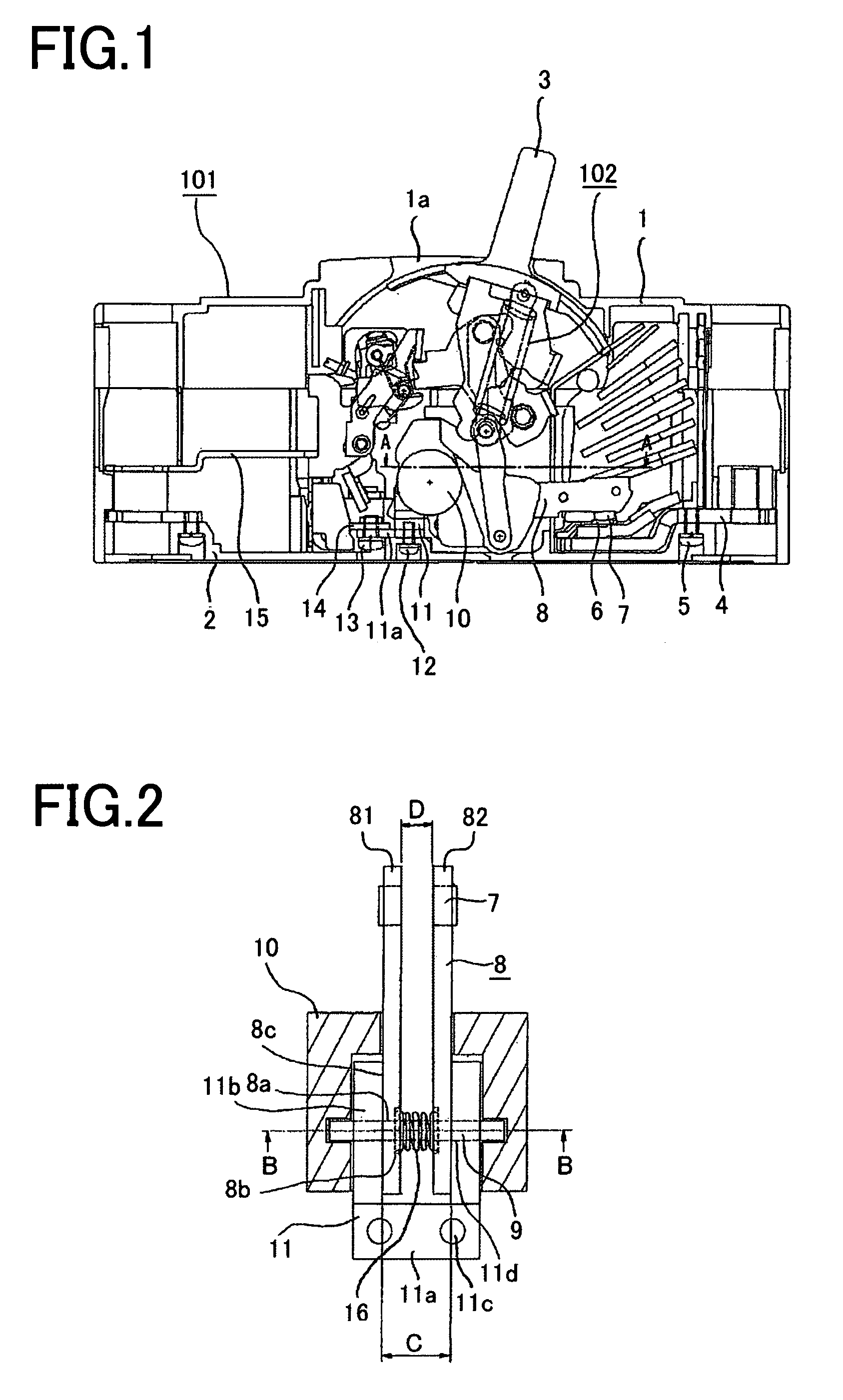Circuit breaker
a circuit breaker and circuit technology, applied in the direction of circuit breaker contacts, circuit breaker switches, relays, etc., can solve the problems of limiting the opening/closing lifetime and wear and tear of contacts, and achieve the effect of high current-carrying performan
- Summary
- Abstract
- Description
- Claims
- Application Information
AI Technical Summary
Benefits of technology
Problems solved by technology
Method used
Image
Examples
embodiment 1
[0038]FIG. 1 is a front elevation illustrating a closed state on of a circuit breaker in Embodiment 1 of the present invention. FIG. 2 is a cross-sectional view taken along Line A-A in FIG. 1, being doubled with a plan of a movable contacting device for single pole. In addition, FIG. 3 is a cross-sectional view taken along Line B-B in FIG. 2.
[0039]Referring to FIG. 1, an enclosure 1 and a case base 2 constitute a case for a circuit breaker 101, each being formed of synthetic resin. The case base 2 houses an opening / closing mechanism 102, an operating handle 3 that is cooperated with the opening / closing mechanism 102 protrudes outwardly from an opening 1a of the enclosure 1, for an operating handle 3, so that the circuit breaker is hand-operable from the outside thereof, as is known in the art. It is also well known in the art that present on the right side of the drawing with respect to the operating handle 3 position of the circuit breaker 101 being in the closed state, is, for ins...
embodiment 2
[0044]In Embodiment 1, assuming increase of the current rating based upon increase of the current-carrying capacity, a plurarity (two) of movable contact arm members 81 and 82 has been used. Another case in which increase of current rating is not anticipated, or a thick movable contact arm 8 is used will be described as Embodiment 2. Here, FIG. 4 is a view corresponding to FIG. 3 in Embodiment 2.
[0045]Referring to FIG. 4, recesses 8b are provided on the opposite lateral side of contact areas 8c of the movable contact arm 8. An elastic member 16 loosely mounted on a shaft 9 is inserted into the recesses 8b. As is the case with Embodiment 1, the elastic member 16 is a compression spring, and the movable contact arm 8 is inserted between a pair of connecting conductors 11b so that the elastic member 16 is sandwiched between the movable contact arm 8 and a movable contact arm support 11. Here, fitting a compression spring, not shown, and the shaft 9 is the same as that shown in Embodime...
embodiment 3
[0047]The fact that also in Embodiment 1 an elastic member 16 is not exteriorly disposed, fully contributes to miniaturization of a shuntless current-carrying mechanism. However, in order to generate a certain level of a contact pressure between a movable contact arm 8 and a movable contact arm support 11, the wire diameter and the winding number need to be taken into account, and a spacing between the movable contact arm 8 (Dimension D as shown in FIG. 2) should not be negligible. A case in which Dimension D is made as narrow as possible will be described as Embodiment 3. Here, FIG. 5 and FIG. 6 are views corresponding to FIG. 2 and FIG. 4 in Embodiment 3, respectively, and FIG. 7 is an outline perspective view of a helical spring employed in Embodiment 3.
[0048]Referring to FIG. 5(a), recesses 8b are provided on lateral surfaces, of movable contact arm members 81 and 82 arranged in parallel, facing each other, i.e., on the opposite side of the surfaces that abut on the movable cont...
PUM
 Login to View More
Login to View More Abstract
Description
Claims
Application Information
 Login to View More
Login to View More - R&D
- Intellectual Property
- Life Sciences
- Materials
- Tech Scout
- Unparalleled Data Quality
- Higher Quality Content
- 60% Fewer Hallucinations
Browse by: Latest US Patents, China's latest patents, Technical Efficacy Thesaurus, Application Domain, Technology Topic, Popular Technical Reports.
© 2025 PatSnap. All rights reserved.Legal|Privacy policy|Modern Slavery Act Transparency Statement|Sitemap|About US| Contact US: help@patsnap.com



